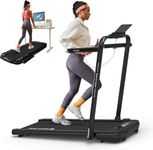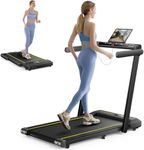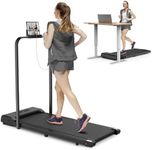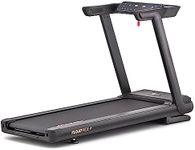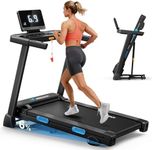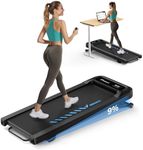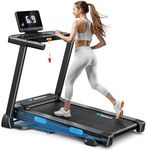Buying Guide for the Best Mini Treadmills
Choosing the right mini-treadmill can significantly enhance your fitness routine, especially if you have limited space at home or need a portable option. When selecting a mini-treadmill, it's important to consider various specifications to ensure it meets your fitness goals and lifestyle needs. Here are some key specs to look out for and how to navigate them.Motor PowerMotor power, measured in horsepower (HP), determines the treadmill's ability to handle different speeds and user weights. A higher HP means the treadmill can support more intense workouts and heavier users. For light walking or jogging, a motor with 1.5 to 2.0 HP is sufficient. For running or more intense workouts, look for a motor with 2.5 HP or higher. Choose based on your intended use: casual walking requires less power, while running needs more.
Speed RangeThe speed range indicates how fast the treadmill can go, usually measured in miles per hour (mph). For walking, a speed range of 0.5 to 4 mph is adequate. For jogging, look for a range up to 6 mph, and for running, consider a treadmill that can reach 8 mph or more. Your fitness goals will guide you here: walkers need lower speeds, while runners need higher speeds.
Incline SettingsIncline settings allow you to simulate uphill walking or running, which can increase the intensity of your workout and target different muscle groups. Some mini-treadmills offer manual incline adjustments, while others have motorized inclines. If you want to add variety and challenge to your workouts, look for a treadmill with multiple incline levels. If you prefer a straightforward workout, a flat treadmill may suffice.
Running SurfaceThe running surface, or belt size, is the area you run or walk on. A larger surface provides more comfort and safety, especially for taller users or those with longer strides. Mini-treadmills typically have smaller surfaces, so ensure it's wide and long enough for your comfort. For walking, a belt length of 40 inches and width of 16 inches is usually sufficient. For running, look for at least 45 inches in length and 18 inches in width.
Portability and StoragePortability and storage are crucial for mini-treadmills, especially if you have limited space. Look for features like foldability, wheels for easy movement, and a compact design that fits under furniture or in closets. If you need to move the treadmill frequently or store it away after use, these features will be very important.
Weight CapacityWeight capacity indicates the maximum user weight the treadmill can safely support. It's important to choose a treadmill with a weight capacity that exceeds your body weight to ensure durability and performance. Most mini-treadmills support between 200 to 300 pounds. Select a treadmill with a higher capacity if you are close to the upper limit to ensure safety and longevity.
Display and ControlsThe display and controls provide information about your workout, such as speed, distance, time, and calories burned. Some treadmills also offer heart rate monitoring and preset workout programs. A clear, easy-to-read display and intuitive controls can enhance your workout experience. Choose a treadmill with the features that will keep you motivated and informed during your exercise sessions.
CushioningCushioning refers to the shock absorption system of the treadmill, which can reduce the impact on your joints. This is especially important if you plan to use the treadmill frequently or have joint issues. Look for treadmills with good cushioning systems if you need extra joint protection. If joint impact is not a major concern, this feature may be less critical.


